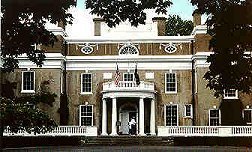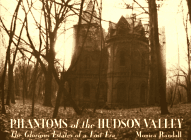Springwood is the childhood home and location of the library of former United States President, Franklin Delano Roosevelt. In 1867 his father purchased the large, circa 1800 farmhouse, and began transforming it into a splendid house of grandeur. With the addition of two large rooms, expansion of the servants  quarters and the construction of a large stable and carriage house, the property began taking form. In 1915 additional renovations began with the erection of wings, a tower and a columned portico. FDR planted new and varied species of trees on the estate, turning portions of it into experimental forestry stations. During his presidency he often yearned to return to his home on the Hudson, amid the peace and beauty, but was not able to pull himself away as often as he would of liked. In 1943, he donated the home to his nation, on condition that his family be allowed to continue use of it after his death. In 1945 the family relinquished their rights to the estate, and it was turned over to the Department of Interior, which maintains it as a nation historic landmark. quarters and the construction of a large stable and carriage house, the property began taking form. In 1915 additional renovations began with the erection of wings, a tower and a columned portico. FDR planted new and varied species of trees on the estate, turning portions of it into experimental forestry stations. During his presidency he often yearned to return to his home on the Hudson, amid the peace and beauty, but was not able to pull himself away as often as he would of liked. In 1943, he donated the home to his nation, on condition that his family be allowed to continue use of it after his death. In 1945 the family relinquished their rights to the estate, and it was turned over to the Department of Interior, which maintains it as a nation historic landmark.
The Hudson Valley is known for the quaint bed and breakfast inns scattered  throughout the area. Cromwall Manor Inn, was built in 1829 by David Cromwall. This country estate, fashioned in Greek Revival architecture, is listed on the National Register of Historical Places. Today, this beautiful property serves as a bed and breakfast for guests, providing them with luxurious accommodations, amid period pieces of furniture and furnishings. The inn is nestled in the northern half of the Hudson Valley, yet is conveniently located to many of the delights that the abound along the River. throughout the area. Cromwall Manor Inn, was built in 1829 by David Cromwall. This country estate, fashioned in Greek Revival architecture, is listed on the National Register of Historical Places. Today, this beautiful property serves as a bed and breakfast for guests, providing them with luxurious accommodations, amid period pieces of furniture and furnishings. The inn is nestled in the northern half of the Hudson Valley, yet is conveniently located to many of the delights that the abound along the River.
Kykuit has been home to four generations of the prestigious Rockefeller  family. The estate is more of a museum with it's collections of chinese ceramics, fine art, period furniture, classic automobiles and horse drawn carriages. Governor Nelson A. Rockefeller displayed his love of the nature, when he designed the outdoor gardens, incorporating 20th-century sculptures and fountains among the formal gardens. A stroll on the terrace of the main house provides a breataking view of the Hudson River, and the Governor's splendid work. family. The estate is more of a museum with it's collections of chinese ceramics, fine art, period furniture, classic automobiles and horse drawn carriages. Governor Nelson A. Rockefeller displayed his love of the nature, when he designed the outdoor gardens, incorporating 20th-century sculptures and fountains among the formal gardens. A stroll on the terrace of the main house provides a breataking view of the Hudson River, and the Governor's splendid work.
Other area attractions:
In 1900, Francis Bannermann purchased an island in the Hudson River, and  constructed a warehouse to store his collection of weapons and war-related items. The building was designed similar to a Scottish castle, and the island was named Bannermann's Island. In addition to the main warehouse, three more were constructed on the island, along with two houses and a lodge. Rumor has it that the lodge is inhabited by the spirit of a sea captain, and Indians believed that the island was haunted. constructed a warehouse to store his collection of weapons and war-related items. The building was designed similar to a Scottish castle, and the island was named Bannermann's Island. In addition to the main warehouse, three more were constructed on the island, along with two houses and a lodge. Rumor has it that the lodge is inhabited by the spirit of a sea captain, and Indians believed that the island was haunted.
A working 18-century farm, filled with a collection of authentic 17th- and 18th-century artifacts, is open to the public in Sleepy Hollow.Philipsburg  Manor was established by Fredric Philips in 1693, after he obtained a grant a charter for 5s,000 acres of land. The grounds include a working water-powered grist mill, farmhouse, and gardens. After the Revolutionary War, descendants of the founder fled to England. In the 1940's, John D. Rockefeller Jr. acquired what was remaining of the property, and restored it, has had become his hobby with historical landmarks. Manor was established by Fredric Philips in 1693, after he obtained a grant a charter for 5s,000 acres of land. The grounds include a working water-powered grist mill, farmhouse, and gardens. After the Revolutionary War, descendants of the founder fled to England. In the 1940's, John D. Rockefeller Jr. acquired what was remaining of the property, and restored it, has had become his hobby with historical landmarks.
The Hudson River is filled with history. On a cool summer evening you can almost hear the past carried on the breeze. This river served as America's  first great waterway, instrumental in the revolutionary war. It was the primary source of communication and transportation for settlers. After the construction of the Erie Canal and the development of roadways, it was continued to be the principal artery for westbound travel. The beauty of the river captured the breath of artists, that flocked to it, casting the rich hues of the river to canvas. The wealthy basked in the serenity of the river, and selected the region for the place to establish their roots. Sit back and listen to the river. first great waterway, instrumental in the revolutionary war. It was the primary source of communication and transportation for settlers. After the construction of the Erie Canal and the development of roadways, it was continued to be the principal artery for westbound travel. The beauty of the river captured the breath of artists, that flocked to it, casting the rich hues of the river to canvas. The wealthy basked in the serenity of the river, and selected the region for the place to establish their roots. Sit back and listen to the river. |

 quarters and the construction of a large stable and carriage house, the property began taking form. In 1915 additional renovations began with the erection of wings, a tower and a columned portico. FDR planted new and varied species of trees on the estate, turning portions of it into experimental forestry stations. During his presidency he often yearned to return to his home on the Hudson, amid the peace and beauty, but was not able to pull himself away as often as he would of liked. In 1943, he donated the home to his nation, on condition that his family be allowed to continue use of it after his death. In 1945 the family relinquished their rights to the estate, and it was turned over to the Department of Interior, which maintains it as a nation historic landmark.
quarters and the construction of a large stable and carriage house, the property began taking form. In 1915 additional renovations began with the erection of wings, a tower and a columned portico. FDR planted new and varied species of trees on the estate, turning portions of it into experimental forestry stations. During his presidency he often yearned to return to his home on the Hudson, amid the peace and beauty, but was not able to pull himself away as often as he would of liked. In 1943, he donated the home to his nation, on condition that his family be allowed to continue use of it after his death. In 1945 the family relinquished their rights to the estate, and it was turned over to the Department of Interior, which maintains it as a nation historic landmark.
 throughout the area. Cromwall Manor Inn, was built in 1829 by David Cromwall. This country estate, fashioned in Greek Revival architecture, is listed on the National Register of Historical Places. Today, this beautiful property serves as a bed and breakfast for guests, providing them with luxurious accommodations, amid period pieces of furniture and furnishings. The inn is nestled in the northern half of the Hudson Valley, yet is conveniently located to many of the delights that the abound along the River.
throughout the area. Cromwall Manor Inn, was built in 1829 by David Cromwall. This country estate, fashioned in Greek Revival architecture, is listed on the National Register of Historical Places. Today, this beautiful property serves as a bed and breakfast for guests, providing them with luxurious accommodations, amid period pieces of furniture and furnishings. The inn is nestled in the northern half of the Hudson Valley, yet is conveniently located to many of the delights that the abound along the River.
 family. The estate is more of a museum with it's collections of chinese ceramics, fine art, period furniture, classic automobiles and horse drawn carriages. Governor Nelson A. Rockefeller displayed his love of the nature, when he designed the outdoor gardens, incorporating 20th-century sculptures and fountains among the formal gardens. A stroll on the terrace of the main house provides a breataking view of the Hudson River, and the Governor's splendid work.
family. The estate is more of a museum with it's collections of chinese ceramics, fine art, period furniture, classic automobiles and horse drawn carriages. Governor Nelson A. Rockefeller displayed his love of the nature, when he designed the outdoor gardens, incorporating 20th-century sculptures and fountains among the formal gardens. A stroll on the terrace of the main house provides a breataking view of the Hudson River, and the Governor's splendid work.
 constructed a warehouse to store his collection of weapons and war-related items. The building was designed similar to a Scottish castle, and the island was named Bannermann's Island. In addition to the main warehouse, three more were constructed on the island, along with two houses and a lodge. Rumor has it that the lodge is inhabited by the spirit of a sea captain, and Indians believed that the island was haunted.
constructed a warehouse to store his collection of weapons and war-related items. The building was designed similar to a Scottish castle, and the island was named Bannermann's Island. In addition to the main warehouse, three more were constructed on the island, along with two houses and a lodge. Rumor has it that the lodge is inhabited by the spirit of a sea captain, and Indians believed that the island was haunted.
 Manor was established by Fredric Philips in 1693, after he obtained a grant a charter for 5s,000 acres of land. The grounds include a working water-powered grist mill, farmhouse, and gardens. After the Revolutionary War, descendants of the founder fled to England. In the 1940's, John D. Rockefeller Jr. acquired what was remaining of the property, and restored it, has had become his hobby with historical landmarks.
Manor was established by Fredric Philips in 1693, after he obtained a grant a charter for 5s,000 acres of land. The grounds include a working water-powered grist mill, farmhouse, and gardens. After the Revolutionary War, descendants of the founder fled to England. In the 1940's, John D. Rockefeller Jr. acquired what was remaining of the property, and restored it, has had become his hobby with historical landmarks.
 first great waterway, instrumental in the revolutionary war. It was the primary source of communication and transportation for settlers. After the construction of the Erie Canal and the development of roadways, it was continued to be the principal artery for westbound travel. The beauty of the river captured the breath of artists, that flocked to it, casting the rich hues of the river to canvas. The wealthy basked in the serenity of the river, and selected the region for the place to establish their roots. Sit back and listen to the river.
first great waterway, instrumental in the revolutionary war. It was the primary source of communication and transportation for settlers. After the construction of the Erie Canal and the development of roadways, it was continued to be the principal artery for westbound travel. The beauty of the river captured the breath of artists, that flocked to it, casting the rich hues of the river to canvas. The wealthy basked in the serenity of the river, and selected the region for the place to establish their roots. Sit back and listen to the river.















